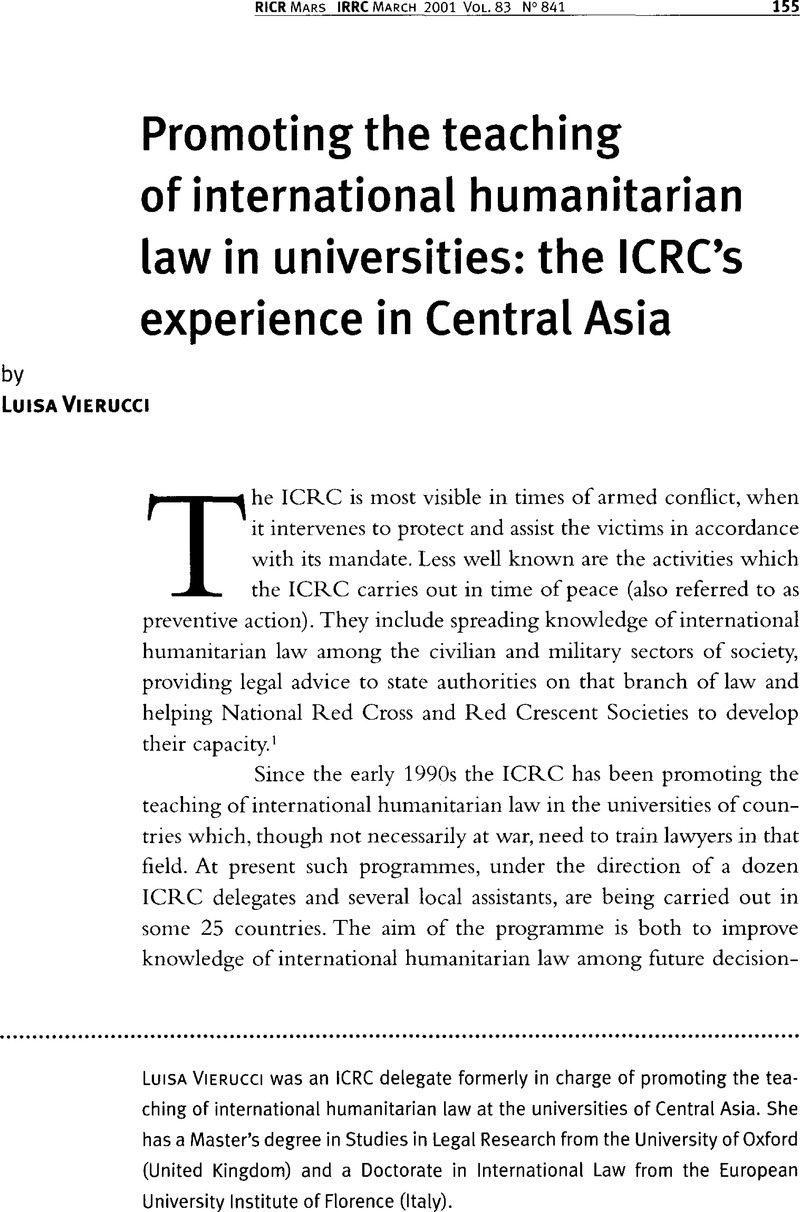No CrossRef data available.
Published online by Cambridge University Press: 19 April 2010

1 See Chopard, J. L., “Dissemination of the humanitarian rules and cooperation with National Red Cross and Red Crescent Societies for the purpose of prevention”, IRRC, No. 306, May-June 1995, pp. 244–262.CrossRefGoogle Scholar
2 During the Soviet era international law was predominantly taught by the universities in Moscow, Kiev and St Petersburg. Moreover, before independence in Central Asia there was little need to develop that branch of law because international relations were maintained primarily from Moscow.
3 Tajikistan has not been included in this programme, because the protracted armed conflict has given rise to special circumstances there.
4 Kazakhstan succeeded to the four Geneva Conventions of 1949 and the two Additional Protocols of 1977 on 5 May 1992, Kyrgyzstan on 18 September 1992 and Turkmenistan on 10 April 1992, whereas Uzbekistan acceded to them on 8 October 1993. – This article refers exclusively to the Geneva Conventions and their Additional Protocols. However, the countries considered in it have ratified (or acceded to) a good number of other conventions which make up international humanitarian law. See <www.icrc.org/ihl>
5 Geneva Convention for the Amelioration of the Condition of the Wounded and Sick in Armed Forces in the Field, Art. 47; Geneva Convention for the Amelioration of the Condition of Wounded, Sick and Shipwrecked Members of Armed Forces at Sea, Art. 48; Geneva Convention relative to the Treatment of Prisoners of War, Art. 127; Geneva Convention relative to the Protection of Civilian Persons in Time of War, Art. 144; and Protocol additional to the Geneva Conventions of 1949 and relating to the Protection of Victims of International Armed Conflicts (Protocol I), Art. 83.
6 1998 in Tashkent, Uzbekistan, and 1999 in Ashgabad, Turkmenistan, the latter in cooperation with the Ruhr-University of Bochum, Germany. See Dorbes, P. and Seidel, S. M., “Second Central Asian Conference on the Teaching of International Humanitarian Law”, Humanitäres Völkerrecht, 2/2000, pp. 72–73.Google Scholar
7 On teaching international humanitarian law at university level, see Sassoli, M. and Bouvier, A., How Does Law Protect in War?, ICRC, Geneva, 1999, pp. 1451–3.Google Scholar This book provides extremely useful guidance for academic staff interested in teaching international humanitarian law, as it contains cases and documents, references to background literature and model outlines for university courses.
8 The Kyrgyz epic, Manas: The Great Campaign, has been translated into English by W. May; it was published in Bishkek in 1999.
9 Before independence, Russian was the official language in the five countries of Central Asia. Today national languages are more and more widely used there in the universities as well, although Russian still plays an important part in the higher educational system of Central Asia.
10 Hankins, S., “Promoting international humanitarian law in higher education and universities in the countries of the Commonwealth of Independent States”, IRRC, No. 319, July-August 1997, p. 447.CrossRefGoogle Scholar